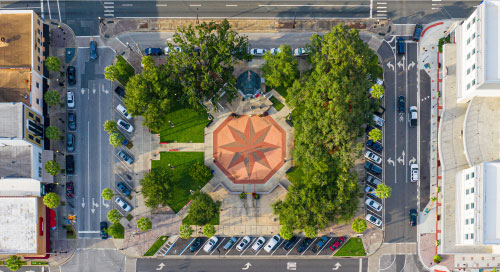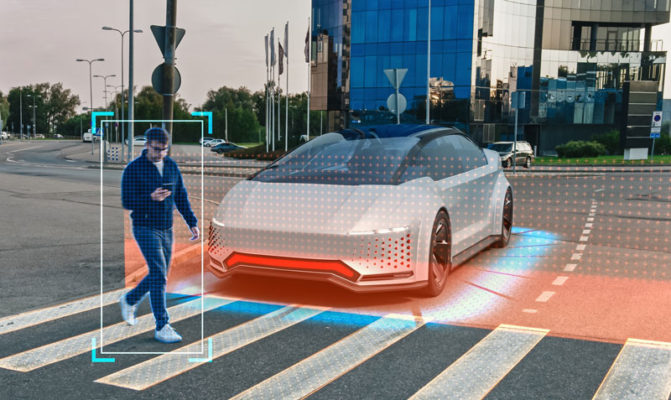Fill form to unlock content
Error - something went wrong!
Your content is just a step away. Please submit below.
Thank you!
AI Video Analytics Make Cities Smarter

Smart cities offer many advantages that traditional municipalities only dream about. With the right technology in place, smart city initiatives can optimize traffic, improve public safety, maintain proper air quality, and enhance the community.
All of this is possible with video analytics powered by artificial intelligence (AI). When connected to surveillance cameras, AI-based video analytics collect data that can improve city life by keeping an eye on the movement around its streets, plazas, parks, and municipal buildings.
For example, one large city in North Africa uses this smart city technology for a host of different purposes—including traffic management systems, stopping illegal parking, preventing loitering and trespassing, and detecting and tracking suspicious vehicles across multiple surveillance cameras. To keep track of all this movement, the city uses an AI platform developed by video analytics provider AllGoVision Technologies, which leverages multiple algorithms to deliver a wide range of functionality.
“We created a generic platform where we can actually pick and choose algorithms that can be used,” says Aji Anirudhan, the company’s Chief Sales and Marketing Officer. “The algorithm which actually comes into play depends on the location where it’s implemented.”
Data collected from crosswalks at busy intersections can help improve safety—potentially keeping citizens out of harm’s way (Figure 1). If data shows a recurrence of accidents in specific spots, city planners can add signs and traffic lights, or redesign traffic lanes, to avoid accidents and ease congestion, Anirudhan says, adding, “Our system then becomes an input to a much bigger planning system for the city.”

“It wasn’t too long ago that surveillance systems were restricted to a small number of users. But today that has changed a lot. Capturing meaningful analytics from video has evolved over the years beyond safety and security to operational efficiency,” Anirudhan continues. “Critical intelligence captured from surveillance cameras helps redefine what city management and planning mean.”
Driving Outcomes with AI Video Analytics
Because of all the benefits that come with these new advancements, AllGoVision aims to help various businesses and industries successfully implement AI solutions. For instance, Anirudhan explains many of its customers often struggle to harness the power of visual intelligence.
“Our technology analyzes video footage to extract valuable visual information, which is then seamlessly integrated with other relevant real-time data sources. By combining visual intelligence with data-driven decision-making processes, AllGoVision empowers our customers to make more-informed and coherent decisions,” he says.
“Capturing meaningful #analytics from #video has evolved over the years beyond safety and security to operational efficiency.” – Aji Anirudhan, @AllGoVision via @insightdottech
Beyond traffic management and pedestrian safety, the platform can help optimize public parking as well as operationalize safety monitoring of utility companies like power and water throughout a municipality.
AllGoVision’s generalist approach makes it customizable to a variety of environments by matching algorithms to desired outcomes. And even better, AllGoVision makes the power of video analytics accessible to all customers, no matter their AI knowledge.
Take gas stations, for example. The use of video analytics helps operators see whether attendants are prompt, efficient, and courteous—which affects customer service. But there’s also an operational aspect. Video monitoring lets operators track all kinds of activities. For instance, if a gas spillage occurred, it can determine if the area has been cleaned or not.
In the classroom, AllGoVision helps gauge a teacher’s effectiveness in engaging students—or whether students are pursuing the right educational track. EdTech companies in countries such as India, where students pay for instruction, leverage behavioral analytics to drive outcomes. And those outcomes translate to revenue for the companies.
“AllGoVision’s advanced algorithms and deep learning capabilities enable us to provide cutting-edge features such as real-time object detection, facial recognition, behavior analysis, and more. These capabilities further enhance the value we bring to our customers’ AI initiatives, allowing them to unlock new possibilities and improve their overall AI maturity,” says Anirudhan.
Open Framework Keeps Costs Down
While using multiple sets of algorithms provides several benefits and opportunities across industries, it also makes the AllGoVision platform processor-intensive—which potentially could get expensive for the customer. But working with Intel has helped the company moderate costs, according to Anirudhan.
By leveraging the Intel® Distribution of OpenVINO™ Toolkit, AllGoVision optimizes the platform’s processing requirements.
“OpenVINO provides an easy-to-use AI toolkit that allows us to port multiple AI models easily to Intel platforms. By supporting CPU and iGPU seamlessly, it allows us to access all the Intel platforms with the same software base. Recent Intel advances in the CPU architecture have enabled us to run more AI models on the CPU without needing an additional GPU,” Anirudhan explains.
OpenVINO is also the key to creating a solution that can handle a variety of use cases.
“OpenVINO can not only support AI and computer vision use cases but can also extend it to natural language processing use cases so that will cover an even broader range of applications. OpenVINO provides a set of tools to help optimize the AI models that developers would use and also help them to deploy to a wide range of hardware for efficient inferencing in real-world use cases,”says Zhuo Wu, a Software Architect at Intel.
In another effort to keep down costs, AllGoVision is cloud-enabling its platform.
“Even if the costs are optimized, when you are running something like a 5,000-camera campus, the CAPEX cost is a challenge for many of our customers to justify. So what we are trying to build is a system where we could work with partners and do a combination of edge-plus-cloud model offered as a SaaS business model,” Anirudhan says.
In this model, cameras and some servers would run on the edge and, depending on the use case, some data would be sent to the cloud for analysis and presentation to the customer.
Another development for the future is to integrate the solution so that different areas of operations can share information and learn from one another’s experience. For instance, data collected at airports, in parking lots, roads, city plazas, and municipal buildings would be aggregated and reviewed in a centralized location to enable a more concerted, organized approach to running a smart city.
This is just the beginning of AI’s impact within smart cities and industries.
This article was edited by Christina Cardoza, Associate Editorial Director for insight.tech.
This article was originally published on January 24, 2023.